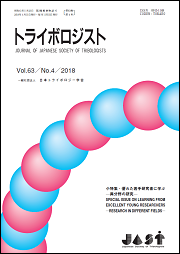Volume 69, Issue 3
Special Issue on Tribology of Polymer Additive and Its Thin Layer
Displaying 1-17 of 17 articles from this issue
- |<
- <
- 1
- >
- >|
Announcement
-
2024 Volume 69 Issue 3 Pages K3-a
Published: March 15, 2024
Released on J-STAGE: March 15, 2024
Download PDF (389K) -
2024 Volume 69 Issue 3 Pages K3-b
Published: March 15, 2024
Released on J-STAGE: March 15, 2024
Download PDF (1575K)
Contents
-
2024 Volume 69 Issue 3 Pages M3
Published: March 15, 2024
Released on J-STAGE: March 15, 2024
Download PDF (259K)
Serial Messages to Tribologists
-
2024 Volume 69 Issue 3 Pages 161
Published: March 15, 2024
Released on J-STAGE: March 15, 2024
Download PDF (462K)
Special Issue on Tribology of Polymer Additive and Its Thin Layer
-
2024 Volume 69 Issue 3 Pages 162
Published: March 15, 2024
Released on J-STAGE: March 15, 2024
Download PDF (188K)
Explanation
-
2024 Volume 69 Issue 3 Pages 163-168
Published: March 15, 2024
Released on J-STAGE: March 15, 2024
Download PDF (3228K) -
2024 Volume 69 Issue 3 Pages 169-174
Published: March 15, 2024
Released on J-STAGE: March 15, 2024
Download PDF (1302K) -
2024 Volume 69 Issue 3 Pages 175-180
Published: March 15, 2024
Released on J-STAGE: March 15, 2024
Download PDF (1604K) -
2024 Volume 69 Issue 3 Pages 181-186
Published: March 15, 2024
Released on J-STAGE: March 15, 2024
Download PDF (1558K) -
2024 Volume 69 Issue 3 Pages 187-194
Published: March 15, 2024
Released on J-STAGE: March 15, 2024
Download PDF (2074K) -
2024 Volume 69 Issue 3 Pages 195-202
Published: March 15, 2024
Released on J-STAGE: March 15, 2024
Download PDF (3821K)
Up-to-date News Tribo-Episode -Tribologist Received Ph.D.-
-
2024 Volume 69 Issue 3 Pages 203-204
Published: March 15, 2024
Released on J-STAGE: March 15, 2024
Download PDF (4203K) -
2024 Volume 69 Issue 3 Pages 205-206
Published: March 15, 2024
Released on J-STAGE: March 15, 2024
Download PDF (2405K)
Original Contribution on Science
-
2024 Volume 69 Issue 3 Pages 207-217
Published: March 15, 2024
Released on J-STAGE: March 15, 2024
Advance online publication: September 13, 2023Download PDF (3966K)
Original Contribution on Technology
-
2024 Volume 69 Issue 3 Pages 218-226
Published: March 15, 2024
Released on J-STAGE: March 15, 2024
Advance online publication: November 21, 2023Download PDF (5864K)
New Products and New Technology
-
2024 Volume 69 Issue 3 Pages 227
Published: March 15, 2024
Released on J-STAGE: March 15, 2024
Download PDF (755K)
Report of the Society
-
2024 Volume 69 Issue 3 Pages 228-233
Published: March 15, 2024
Released on J-STAGE: March 15, 2024
Download PDF (1015K)
- |<
- <
- 1
- >
- >|
